В.Обухович, А.Никифоров Самолеты Первой Мировой войны
Версия W 18 в основном отличалась коробкой крыльев: увеличился размах, законцовки крыльев были скруглены, стойки упростились, нижнее крыло получило небольшую стреловидность. Незначительно изменилась форма стабилизатора. Вооружение состояло из двух неподвижных пулеметов в фюзеляже. Вес самолета увеличился на 75 кг.
O.Thetford, P.Gray German Aircraft of the First World War (Putnam)
Brandenburg W 18
Although only one machine (No. 2138) was supplied to the German Navy in 1917, a slightly modified version powered with 200 h.p. Hiero engine was supplied to the Austro-Hungarian Navy. This single-seat flying-boat fighter was an improvement on the similar C.C. type developed for the Austrians. Engine, 150 h.p. Benz Bz III. Span, 10.7 m. (35 ft. 1 1/4 in.). Length, 8.15 m. (26 ft. 8 7/8 in.). Height, 3.45 m. (11 ft. 3 7/8 in.). Area, 34.38 sq.m. (271 sq.ft.). Weights: Empty, 875 kg. (1,925 lb.). Loaded, 1,145 kg. (2,519 lb.). Speed, 160 km.hr. (100 m.p.h.). Climb, 1,000 m. (3,280 ft.) in 5 min., 3,000 m. (9,840 ft.) in 23 min. Armament, two Spandau machine-guns. (Above aircraft had only one fitted when photographed.)
W.Green, G.Swanborough The Complete Book of Fighters
BRANDENBURG W 18
The W18 single-seat fighter flying boat was, like the CC that it supplanted, intended primarily for the Austro-Hungarian Navy. The prototype was flown early in 1917 with a 150 hp Benz Bz III six-cylinder water-cooled engine, and production with a 200 hp Hiero engine was undertaken on behalf of the Austro-Hungarian Navy, a total of 47 being delivered between September 1917 and May 1918. Armament normally comprised two fixed forward-firing 8-mm Schwarzlose machine guns, and the W 18 was employed for both station defence and fighter patrol tasks. One Benz-engined example was delivered to the German Navy in December 1917.
Max speed, 106 mph (170 km/h).
Time to 3,280 ft (1 000 m), 5.0 min, to 9,840 ft (3 000 m), 23.0 min.
Empty weight, 1,929 lb (875 kg).
Loaded weight, 2,524 lb (1145 kg).
Span, 35 ft 1 1/4 in (10,70 m).
Length, 26 ft 8 7/8 in (8,15 m).
Height, 11 ft 3 7/8 in (3,45 m).
Wing area, 370.07 sqft (34,38 m2).
BRANDENBURG W 23
Employing single-bay biplane wings similar to those of the W 18 coupled with a lengthened, aero- and hydrodynamically refined hull, the W 23 single-seat fighter flying boat was designed to mount a single fixed forward-firing 20-mm Becker cannon. This was mounted in the starboard side of the upper decking of the hull nose with a 7,92-mm LMG 08/15 machine gun mounted to port. Power was provided by a 160 hp Mercedes six-cylinder water-cooled engine driving a two-bladed pusher propeller. The structure was wooden with fabric and plywood skinning. Three prototypes were ordered in June 1917, these being delivered for evaluation in January 1918. The W 23 proved to possess such poor flight characteristics that no further development was undertaken.
Max speed, 102 mph (165 km/h).
Empty weight, 2,024 lb (918 kg).
Loaded weight, 2,780 lb (1261 kg).
Span, 35 ft 1 1/4 min (10,70 m).
Length, 29 ft 11 7/8 in (9,14 m).
Height, 10 ft 11 7.8 in (3,35 m).
Wing area, 373.52 sq ft (34,7 m2).
J.Herris German Seaplane Fighters of WWI (A Centennial Perspective on Great War Airplanes 2)
Brandenburg W18
The Brandenburg W18 flying boat fighter was a further development of the Type CC, this time using a more conventional wing cellule. One example, Marine #2138, was supplied to the German Navy, but with little German interest in flying boats only the single W18 was delivered.
However, like the Type CC, the W18 was widely used by the Austro-Hungarian Navy. In December 1916 47 aircraft, serials A.50-A.96, were ordered. These mounted two fixed Schwarzlose machine guns and were powered by the 230 hp Hiero engine, although some aircraft were delivered with 200 hp Hiero engines due to shortages of the more powerful engine. The W18s were used for both station defense and for escorting bombing raids on Italian targets.
C.Owers Hansa-Brandenburg Aircraft of WWI Vol.2: Biplane Seaplanes (A Centennial Perspective on Great War Airplanes 18)
Type W.18
The W.18 was a version of the CC single-seat fighter flying boat. One was supplied to the German Navy in December 1917, as a Class E2MG machine, with MN 2138, and a Benz Bz.III engine. The W.18 reverted to conventional interplane bracing with struts and cables. The wings were equal in chord but the lower wing was swept back. Armament was two Maxim 08/15 machine guns. The German Navy then appear to have had no interest in the machine.
A slightly modified version with a 230-hp Hiero engine went to the Austro-Hungarian Navy. On 14 December 1916, 47 boats were ordered by the kuk Kriegsmarine. Given the serials A50 - A96, the Austro-Hungarian machines differed from the German prototype. The hull was lengthened to provide better stability, and modified to fit 8-mm Schwarzlose machine guns to the nose. The wing cellule was modified as were the tailplane and elevators. All 47 boats were delivered by the end of February 1918, and were in service in the Adriatic. A88 - A96 had been accepted without engines, probably as replacement boats, and were in service by May 1918. The problem with engine supply meant that some W.18 boats were fitted with the 200-hp Hiero.
Phonix built a much-modified version as the Phonix A. Sixty were constructed (A61 - A120). They had a single machine gun as against the two guns of the German model. The type could take on the Italian Nieuport 11 fighters but their short endurance restricted them to operating close to the naval air stations where they were based. They were replaced by Phonix D.I landplanes when the Italians introduced new aircraft towards the end of 1917. The Phonix D series was developed from the Brandenburg D.I fighters built under licence.
The Royal Yugoslav Navy used at least one W.18 flying boat post-war. It was a school machine and carried the serial N9.
The US Navy received ex-Austro-Hungarian W.18 A87 after the war along with Lohner S.3, S26, L126, R9 and Mickl A125. These machines were shipped to the US by the USS Nereus in April 1920. A later listing gives S32 instead of S3 and A126 instead of A125. The W.18 had a 230-hp Hiero engine. None of these boats were considered airworthy and they were given Bureau Nos. A-6049 to A-6054 inclusive in April 1921 for record purposes as they were not considered to be worth the expense of placing them into flying condition. No indication of a connection between the Bureau Numbers and the aircraft has been found. On 5 May 1921, Survey Report 182-21 recommended that they be stricken. This was carried out in September when they were stricken as a group. No photographs of these machines in US hands are known to exist.
Type W.18 Production
Serials Notes
A50 - A51 200-hp Hiero.
A51 - A70 230-hp Hiero. A52 was delivered in German naval hexagon camouflage.
A71 - A72 200-hp Hiero.
A73 - A79 230-hp Hiero.
A80 - A86 200-hp Hiero.
A87 230-hp Hiero.
A88 - A96 Supplied without engine.
Brandenburg W.18 Specifications
Source Typenschau Gray & Thetford SVK MN 2138 George Haddow Data Schupita Data
Dimensions in m
Span 10.70/10.30 10.7 10.700/10.300 10.7/8.92 10.7/10.3
Chord 1.80 - 1.800 - -
Length 8.15 8.15 8.150 8.64 8.15
Hull Length 7.60 - 7.600 - -
Hull Width 0.965 - 0.965 - -
Height - 3.45 3.450 3.45 -
Areas in m2
Wings 34.38 34.38 34.38 - -
Ailerons 1.90 - 1.90 - -
Elevators 1.08 - 1.08 - -
Rudder 0.57 - 0.57 - -
Weights in kg
Empty 875 875 875 812 716
Loaded 1,145 1,145 1,145 1,092 941
Performance
Speed in km/hr 160 160 - 180 -
Time to 800 m 3.9 minutes - 3.9 minutes - -
Time to 1000 m 5 minutes 5 minutes 5 minutes 5 minutes -
Time to 1500 m 8.1 minutes - 8.1 minutes - -
Time to 2000 m 11.2 minutes - 11.2 minutes 11.2 minutes 9 minutes
Time to 3000 m 23.4 minutes 23 minutes 23.4 minutes 23.4 minutes 15 minutes
Ceiling, m - - - 4,000 5,000
Range - - - 400 km -
Motor 200-hp Hiero 150-hp Benz Bz.m 150-hp Benz 230-hp Hiero 200-hp Hiero/230-hp Hiero
Type W.23
The W.23 was a further development of the single-seat fighting flying boat. Three of the experimental Class EMGMK were ordered, MN 1647 - 1649. The machine was to be armed with one machine gun and a 2-cm Becker cannon. The boat was of conventional Brandenburg construction and resembled the other boats in the Brandenburg family with its pusher installation, swept lower wing, single-step hull, and wing floats.
All three were built and delivered. MN 1647 was recorded at the Hage Repair Depot in November 1918. Further details are lacking. One source states that they had poor flight characteristics.(22)
(22) Leaman, P. "The Hansa-Brandenburg Seaplanes Pt.3," Cross & Cockade International, UK, 2011. Vol.42 P.97.
Brandenburg W.23 Specifications
Source Typenschau Branden. 3-View* SVK MN 1647
Dimensions in m
Span, Upper 10.70 10.700 10.700
Span, Lower 10.24 10.240 10.130
Chord, Upper 1.80 1.800
Chord, Lower 1.80 1.650
Length 9.13 9.140 9.125
Height 3.600
Hull Length 8.60 8.600
Hull Width 1.00 1.000
Areas in m2
Wings 34.70 34.7
Ailerons 2.25 2.10 2.25
Elevators 1.00 1.04 1.00
Rudder 0.50 0.45 0.50
Weights in kg
Empty 918 918 907
Loaded 1,261 1,261 1,250
Performance
Speed in km/hr 165 165
Time to 800 m 6 min. 6 min.
Time to 1000 m 7 min. 7.7 min.
Time to 1500 m 12 min. 12 min.
Time to 2000 m 18.2 min. 18.2 min.
Time to 3000 m 38.3 min. 38.3 min.
Motor 160-hp Mercedes 105-hp Mercedes 160-hp Mercedes
* 3-view dated 14.01.19
E.Hauke, W.Schroeder, B.Totschinger Die Flugzeuge der k.u.k. Luftfahrtruppe und Seeflieger 1914-1918
Kampfflugboote
A.50. Type Brandenburg W.18 FI 200
A.51. Type Brandenburg W.18 FI 200
A.52. Type Brandenburg W.18 H 200
A.53. Type Brandenburg W.18 H 200
A.54. - A.60. Type Brandenburg W.18 FI 200
A.61. Type Brandenburg W.18 H 200
A.62. - A.65. Type Brandenburg W.18 FI 200
A.66. Type Brandenburg W.18 H 200
A.67. Type Brandenburg W.18 H 200
A.68. Type Brandenburg W.18 FI 200
A.69. Type Brandenburg W.18 H 200
A.70. - A.76. Type Brandenburg W.18 FI 200
A.77. Type Brandenburg W.18 H 200
A.78. - A.80. Type Brandenburg W.18 FI 200
A.81. Type Brandenburg W.18 H 200
A.82. Type Brandenburg W.18 FI 200
A.83. Type Brandenburg W.18 FI 200
A.84. - A.93. Type Brandenburg W.18 H 200
A.94. Type Brandenburg W.18 ohne Motor
A.95. Type Brandenburg W.18 H 200
A.96. Type Brandenburg W.18 Dm 200
 |
C.Owers - Hansa-Brandenburg Aircraft of WWI. Volume 2 - Biplane Seaplanes /Centennial Perspective/ (18)
|
| The German prototype W18 before its Marine Number, 2138, was painted on the hull. The German Navy preferred floatplanes and no more W18s were supplied to Germany. Standard late-war naval camouflage was applied.
|
 |
J.Davilla - Italian Aviation in the First World War. Vol.1: Operations /Centennial Perspective/ (73)
|
| Brandenburg W.18 A.50., EF Stb MaschWart Eduard Trober, Seeflugstation Triest, November-December 1917
|
 |
C.Owers - Hansa-Brandenburg Aircraft of WWI. Volume 2 - Biplane Seaplanes /Centennial Perspective/ (18)
|
| Brandenburg W.18 A.60. was one of the first batch of W.18 aircraft powered by the 230 hp Hiero for the kuk Kriegsmarine. Was in service in the Adriatic for some 10 months from December 1917, until written off due to age.
|
 |
E.Hauke, W.Schroeder, B.Totschinger - Die Flugzeuge der k.u.k. Luftfahrtruppe und Seeflieger 1914-1918
|
| Hansa-Brandenburg W.18 A 68 Triest Juli 1918
|
 |
E.Hauke, W.Schroeder, B.Totschinger - Die Flugzeuge der k.u.k. Luftfahrtruppe und Seeflieger 1914-1918
|
| Hansa-Brandenburg W.18 A 71 Triest März 1918
|
 |
E.Hauke, W.Schroeder, B.Totschinger - Die Flugzeuge der k.u.k. Luftfahrtruppe und Seeflieger 1914-1918
|
| Brandenburg W.18
|
 |
C.Owers - Hansa-Brandenburg Aircraft of WWI. Volume 2 - Biplane Seaplanes /Centennial Perspective/ (18)
|
| Brandenburg W.18 A.78. 'V' was powered by the 230 hp Hiero. Was accepted on 09.07.17. Serving with Banfield's squadron at Trieste, it was captured by the Italians on 4 May 1918 and was written off.
|
 |
E.Hauke, W.Schroeder, B.Totschinger - Die Flugzeuge der k.u.k. Luftfahrtruppe und Seeflieger 1914-1918
|
| Hansa-Brandenburg W.18 A 78 Triest Mai 1918
|
 |
C.Owers - Hansa-Brandenburg Aircraft of WWI. Volume 2 - Biplane Seaplanes /Centennial Perspective/ (18)
|
| Brandenburg W.18 A.89. The airframes for A.88 - A.96 were built in Germany and delivered without a motor or guns to the kuk Kriegsmarine.
|
 |
C.Owers - Hansa-Brandenburg Aircraft of WWI. Volume 2 - Biplane Seaplanes /Centennial Perspective/ (18)
|
| Brandenburg W.18 A.90.
|
 |
C.Owers - Hansa-Brandenburg Aircraft of WWI. Volume 2 - Biplane Seaplanes /Centennial Perspective/ (18)
|
| Brandenburg W.18 A.91. was captured by the Italians. It was one of the first batch of W.18 aircraft powered by the 230 hp Hiero for the kuk Kriegsmarine.
|
 |
В.Обухович, А.Никифоров - Самолеты Первой Мировой войны
|
| Ганза-Бранденбург K
|
 |
C.Owers - Hansa-Brandenburg Aircraft of WWI. Volume 2 - Biplane Seaplanes /Centennial Perspective/ (18)
|
| Developed from the CC, the W18 used conventional interplane struts, which weighed less than the star-struts of the CC. Only one was supplied to the German Navy, but fitted with two guns and either the 200 hp or 230 hp Hiero engine, it was a great success operating with the Austro-Hungarian Navy, which liked flying boats. Its Marine Number 2138 is chalked on the side of the fuselage. The machine has the late-war hexagonal camouflage painted on the hull turtledeck. Note the location of the twin machine guns.
|
 |
J.Herris - German Seaplane Fighters of WWI /Centennial Perspective/ (2)
|
The German W18 had conventional wing struts, two guns, and the standard late-war German naval camouflage.
Produced in quantity for the Austro-Hungarian Navy, the Brandenburg W18 followed the CC into service.
|
 |
C.Owers - Hansa-Brandenburg Aircraft of WWI. Volume 2 - Biplane Seaplanes /Centennial Perspective/ (18)
|
|
|
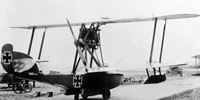 |
J.Herris - German Seaplane Fighters of WWI /Centennial Perspective/ (2)
|
| The W18 had conventional wing struts, two guns, and the standard late-war German naval camouflage.
|
 |
C.Owers - Hansa-Brandenburg Aircraft of WWI. Volume 2 - Biplane Seaplanes /Centennial Perspective/ (18)
|
| This W.18 is in the hexagonal camouflage to wings and hull. It has a small unbalanced rudder. It may be MN 2138 but late production boats for Austro-Hungary were in this color scheme.
|
 |
J.Herris - German Seaplane Fighters of WWI /Centennial Perspective/ (2)
|
| An Austro-Hungarian naval fighter pilot readies for his next mission in W18 A.50. Note the location of the machine gun along the top longeron.
|
 |
C.Owers - Hansa-Brandenburg Aircraft of WWI. Volume 2 - Biplane Seaplanes /Centennial Perspective/ (18)
|
| A.52 was delivered in the German hexagon camouflage scheme; Puntisella, October 1917.
|
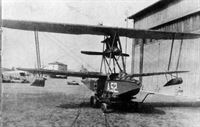 |
E.Hauke, W.Schroeder, B.Totschinger - Die Flugzeuge der k.u.k. Luftfahrtruppe und Seeflieger 1914-1918
|
Abwehrflugzeug A.52, Type Brandenburg W.18, Puntisella, Oktober 1917 nach der Abnahme, auf den Oberseiten deutsches Marinetarnschema mit regelmäßigen Sechsecken
Самолет A.52, тип Brandenburg W.18, Пунтиселла, октябрь 1917 г., после принятия, немецкий шестиугольный военно-морской камуфляж на верхних поверхностях
|
 |
C.Owers - Hansa-Brandenburg Aircraft of WWI. Volume 2 - Biplane Seaplanes /Centennial Perspective/ (18)
|
|
|
 |
E.Hauke, W.Schroeder, B.Totschinger - Die Flugzeuge der k.u.k. Luftfahrtruppe und Seeflieger 1914-1918
|
Austro-Hungarian W.18 serial A.71 in its launching cradle on the hardstand at Puntisella, January 1918. Sfr. Franz Pichl prepares for a sortie.
A.71 was one of 47 Brandenburg W.18s that served with the Austro-Hungarian Navy, which liked flying boats. Fitted with two guns and powered by a 230 hp Hiero engine, the W.18 served successfully in the Adriatic until the end of the war. The red/white/red Austro-Hungarian colors can be seen under the upper right wingtip.
Abwehrflugzeug A.71, Type Brandenburg W.18, Puntisella, Jänner 1918; Sfr Franz Pichl bereitet sich auf den Start vor. im Hintergrund steht der erbeutete Macchi M.5, versehen mit k.u.k. Markierungen und als Schulflugzeug verwendet
Самолет A.71, тип Brandenburg W.18, Пунтиселла, январь 1918 г .; Франц Пихль готовится к старту. На заднем плане - трофейный Macchi M.5, отмеченный символом k.u.k., использовался как учебно-тренировочный самолет
|
 |
C.Owers - Hansa-Brandenburg Aircraft of WWI. Volume 2 - Biplane Seaplanes /Centennial Perspective/ (18)
|
| W.18 A.77 on the slipway.
|
 |
C.Owers - Hansa-Brandenburg Aircraft of WWI. Volume 2 - Biplane Seaplanes /Centennial Perspective/ (18)
|
| W.18 A77 leaving the slipway.
|
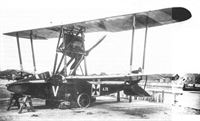 |
J.Davilla - Italian Aviation in the First World War. Vol.1: Operations /Centennial Perspective/ (73)
|
| The Brandenburg W.18 was the best AH flying boat fighter. A.78 was captured by the Italians on 4 May 1918. The serial on the nose has been scraped off and remarked on the rear in a much smaller size. The "V" was the marking for Gottfried Banfield's squadron based at Trieste. According to Banfield the Roman numerals were used up as high as VII.
|
 |
C.Owers - Hansa-Brandenburg Aircraft of WWI. Volume 2 - Biplane Seaplanes /Centennial Perspective/ (18)
|
| W.18 fighters of Banfield's unit at Trieste, May 1918. Aircraft V (A78) and VI, appear to being readied for a sortie.
|
 |
J.Herris - German Seaplane Fighters of WWI /Centennial Perspective/ (2)
|
| This view of A.78. shows the red/white/red Austro-Hungarian markings under the upper wings and black outline to the iron cross insignia below the lower wings. Flying surfaces were clear-doped linen and the wood fuselage was stained. The old position of the serial shows as on the hull where it was scraped off.
|
 |
C.Owers - Hansa-Brandenburg Aircraft of WWI. Volume 2 - Biplane Seaplanes /Centennial Perspective/ (18)
|
| Flieger Quartiermeister Reinhold Haschke (four victories) poses with A.89 at Gjenovics, July 1918.The Schwarzlose machine gun can be seen mounted alongside the cockpit.The cartridge ejection chute can be seen above the "8" of the serial. This was to catch shells and prevent them striking the pusher propeller. This W.18 has the upper wing striped red and white as well as the tailplane, otherwise it is in plain finish. The bombs are for show as the machine was not equipped to carry bombs.
|
 |
J.Herris - German Seaplane Fighters of WWI /Centennial Perspective/ (2)
|
| W18 A.91 in Italian hands displays damage to the rear and bow of the hull. The windows on the fairing in front of the cockpit are visible.
|
 |
C.Owers - Hansa-Brandenburg Aircraft of WWI. Volume 2 - Biplane Seaplanes /Centennial Perspective/ (18)
|
| The remains of A68 in a wrecked aircraft dump.
|
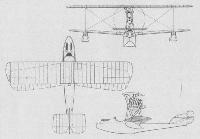 |
W.Green, G.Swanborough - The Complete Book of Fighters
|
| The W18 in production form with Hiero engine.
|
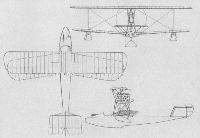 |
W.Green, G.Swanborough - The Complete Book of Fighters
|
| The single prototype of the Brandenburg W 23.
|
 |
C.Owers - Hansa-Brandenburg Aircraft of WWI. Volume 2 - Biplane Seaplanes /Centennial Perspective/ (18)
|
| Brandenburg W.18 SVK Drawing
|
 |
C.Owers - Hansa-Brandenburg Aircraft of WWI. Volume 2 - Biplane Seaplanes /Centennial Perspective/ (18)
|
| Brandenburg W.23 SVK Drawing
|
 |
C.Owers - Hansa-Brandenburg Aircraft of WWI. Volume 2 - Biplane Seaplanes /Centennial Perspective/ (18)
|
| Brandenburg W.23 Factory Drawing
|
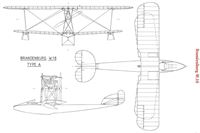 |
C.Owers - Hansa-Brandenburg Aircraft of WWI. Volume 2 - Biplane Seaplanes /Centennial Perspective/ (18)
|
| Brandenburg W.18
|
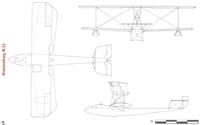 |
C.Owers - Hansa-Brandenburg Aircraft of WWI. Volume 2 - Biplane Seaplanes /Centennial Perspective/ (18)
|
| Brandenburg W.23
|






































